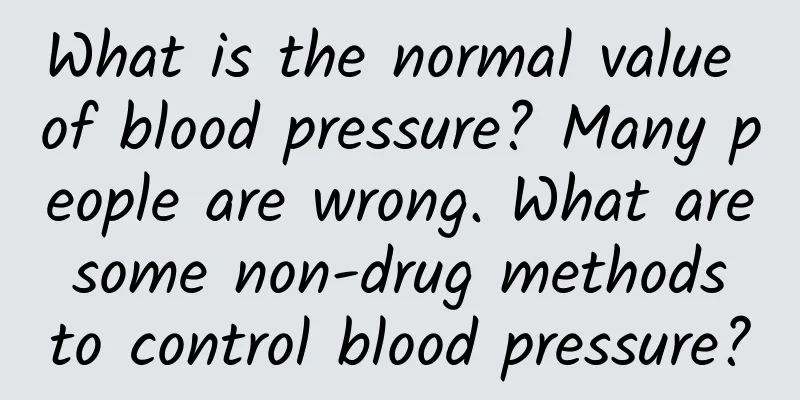What is the normal value of blood pressure? Many people are wrong. What are some non-drug methods to control blood pressure?

|
Huazi chatted with many friends who have high blood pressure and found that many people have misunderstandings about blood pressure. Many people think that blood pressure below 140/90 mmHg is normal, and they use this value as the blood pressure reduction target when taking medicine. In fact, they have misunderstood. Normal blood pressure is not below 140/90 mmHg. Normal blood pressure is a systolic value below 129 mmHg and a diastolic value below 84 mmHg. Ideal blood pressure is a systolic value below 120 mmHg and a diastolic value below 80 mmHg. 1. What is the “normal high value” of blood pressure? The blood pressure index of 140/90 mmHg, which is familiar to everyone, is the diagnostic standard for hypertension in my country. As long as the blood pressure is over 140/90 mmHg three times on different days, it can be diagnosed as hypertension. When the high blood pressure reaches 130~139 mmHg, or the low blood pressure reaches 85~89 mmHg, it is not considered high blood pressure, but it is not considered normal blood pressure either. It is the "normal high value" in blood pressure. Blood pressure at a high normal level is only one step away from hypertension. Although it has not yet reached the standard for medication, it is still necessary to actively control blood pressure. 2. Non-drug methods of controlling blood pressure People whose blood pressure is at a high normal level and those who have been diagnosed with hypertension need to intervene in their blood pressure through lifestyle intervention, which is non-drug method of controlling blood pressure. 1. Salt restriction: According to the latest hypertension treatment guidelines, the daily salt intake should be limited to less than 5g. In related studies, a 1g reduction in daily sodium ion intake can reduce systolic blood pressure (high blood pressure) by 6mmHg. But everyone should note that salt restriction does not mean no salt at all, otherwise it may cause hyponatremia and affect health. A more reasonable daily salt intake is 3~5g. 2. Exercise: Do 150-300 minutes of moderate-intensity exercise per week. You can choose to exercise on 5 days, 30-60 minutes each time, and do resistance exercise (strength training) on the other 2 days. If you keep exercising, your systolic blood pressure can be reduced by 8 mmHg. 3. Lose weight: Obese people with high blood pressure should lose weight to keep their body mass index (BMI) below 24, and their waist circumference should be less than 90cm for men and less than 85cm for women. Losing 10kg can lower blood pressure by 5~20mmHg. 4. Healthy diet: Without increasing the overall calorie intake, increase the intake of vegetables, fruits, whole grains, beans, and dairy products, and reduce the intake of refined rice, refined noodles, and oils, which can reduce systolic blood pressure by 11 mmHg. 5. Limit alcohol intake: The daily alcohol intake should not exceed 25g for men and 15g for women. People with high blood pressure should not drink alcohol. For people who have the habit of drinking, limiting alcohol intake can reduce blood pressure by 3.31/2.04mmHg. 3. Blood pressure measured at home is more accurate than in the hospital About one-third of people have "white coat hypertension". This means that some people get nervous when they see a doctor's white coat, which causes their blood pressure to be higher when measured in a hospital clinic. Therefore, the blood pressure measured at home is more accurate than that measured in a hospital. Because people can relax more in a home environment, if the blood pressure value measured at home reaches or exceeds 135/85 mmHg without taking antihypertensive drugs, it can be diagnosed as hypertension, rather than using the 140/90 mmHg standard of the hospital clinic. 4. The blood pressure target is lower than most people think For people with high blood pressure, keeping blood pressure below 140/90 mmHg is only the most basic goal when taking antihypertensive treatment. To better protect important organs such as the kidneys, heart, and brain, the blood pressure control target should be lower. If you don't want diseases such as cerebral hemorrhage, cerebral infarction, myocardial infarction, and renal failure to come to you, then you must "strictly" control your blood pressure. It is recommended that for hypertensive patients under the age of 65, the blood pressure reduction target is systolic pressure below 120 mmHg and diastolic pressure below 80 mmHg. Elderly hypertensive patients over 65 years old have poor tolerance to lowering blood pressure, so their blood pressure can be gradually lowered in stages. First, lower the blood pressure to 140/90 mmHg, then observe for two weeks to adapt, and then adjust the antihypertensive drugs to continue lowering it to 130/80 mmHg. To sum up, the blood pressure index of 140/90mmHg, which is familiar to everyone, is the diagnostic value of hypertension. The ideal blood pressure is below 120/80mmHg, and the normal blood pressure is below 129/84mmHg. The ideal goal of blood pressure control is below 120/80mmHg, but for the elderly over 65 years old, the blood pressure target can be relaxed to 130/80mmHg. The choice of antihypertensive drugs needs to be carried out under the guidance of a doctor. If you have any questions about the use of drugs, please consult a doctor or pharmacist. I am pharmacist Huazi, welcome to follow me and share more health knowledge. |
Recommend
What should I do if I have a crush on a girl during the epidemic? Is it appropriate to confess to the girl I like after the epidemic?
During the epidemic, what should you do if the gi...
What should women eat if they are calcium deficient?
Calcium is an important element for maintaining o...
Orthopedic disease rumors debunked 5 | Osteoporosis is a minor disease, no need to make a fuss about it"??
Osteoporosis is a common chronic bone disease cha...
What should parents do if their child has a fever?
At a time when respiratory diseases are rampant, ...
What is Cockscomb? Cockscomb Varieties
Cockscomb has feather-like flowers, flame-like co...
Will the mother become more beautiful if she is pregnant with a boy?
The probability of a woman having a boy or a girl...
The most common symptoms of low estrogen levels are
Estrogen is an important hormone in the human bod...
Picture of bleeding during pregnancy
Pregnant women are prone to constipation, which i...
Laryngeal cancer: challenges and hopes of exploring voices
In the complex physiological structure of the hum...
Bleeding at 15 weeks of pregnancy
Bleeding at 15 weeks of pregnancy may be a sign o...
What to do if nipples turn black
The darkening of nipples cannot be ignored. You s...
What are the reasons for girls' stomach pain
Girls' stomach pain should be treated accordi...
Treatment of kidney crystals in women
Kidney stones are not limited to men and women. A...
"WHO warns: Sweeteners can cause diabetes and cardiovascular disease"? Sugar-free drinks are no longer acceptable?
On May 15, the World Health Organization released...
Is it normal to have no obvious fetal movement at 21 weeks?
During pregnancy, when the baby develops to a cer...









